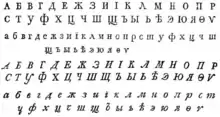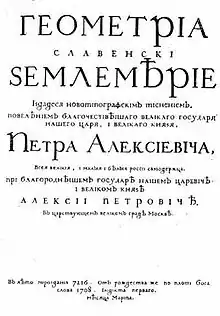Civil Script
The Civil Script (Russian: Гражда́нский шрифт) or, colloquially, the Russian Cyrillic, is a modification of the Cyrillic script introduced by the Russian Tsar Peter the Great in the period from 1708 to 1710. The aim was to alter the appearance of Russian, making it more similar to Western European writing of that time (i.e., early Baroque Franco-Italian).


In January 1707, according to a draft probably made by Peter the Great himself. In the first quarter of the 19th century, the civil alphabet was adopted in Serbia and Bulgaria and gradually replaced the Church Slavonic alphabet. The reform of Peter I radically changed the development of the Russian alphabet and the Cyrillic alphabet as a whole. The development of the Cyrillic alphabet overtakes the Renaissance period from the development of typography in Western Europe and from the medieval stage, which is located until then, is equated with the late Baroque Latin typography. The genetic link between the Cyrillic alphabet and the Greek alphabet has been removed. Prior to this reform, centuries ago, the Cyrillic script of the Venetian term and the orthographic bequest of the Preslav Literary School - followed the Greek calligraphic and typographic tradition.[1]
References
- "ЭСБЕ/Гражданский шрифт — Викитека". ru.wikisource.org. Retrieved 2020-02-05.